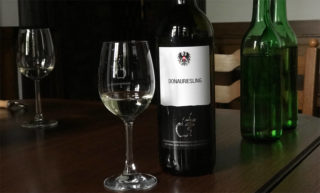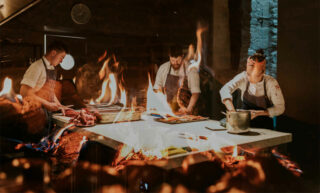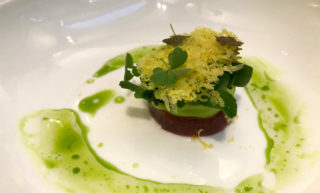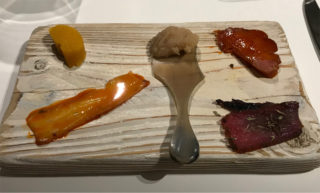More Finesse and A Sea of Rosé
Languedoc is a wine region known for its diversity, its blends, its sometimes rather 'warm' wines and its great value for money. With 38 appellations and terroirs/denominations, it is also a large wine region, and therefore sometimes a bit confusing. But at a press trip in June 2024, I learned that most appellations seemed to be heading in the same direction.
It’s a familiar party game among wine aficionados. Which wine blew the fuses on you and led to the decision to pursue a career in the wine world? Some people have a single, straightforward answer to this, but I myself would rather name ten moments that slowly sparked interest. One winery that tickled my interest in wine early on was Paul Mas. My father bought French wines from a friend who bought wines for his friends. Over time, friends of friends joined and a leaflet was published, which gradually evolved into a full-colour brochure. The focus was on wines with finesse, elegance and affordability. For a young twenty-something like me at the time, the latter was a plus. Paul Mas’ wines were among the cheapest. For just under five guilders a bottle, you could subscribe to his entry-level Claude Val. I haven’t drunk it for years now, but at the time I thought it was quite decent. Smooth, fruity, simple but good. And apparently the Wine Friends Club thought so too, because to this day it is in the brochure.
East-West
In June I was in the Languedoc again after a long absence. It can be difficult to see the often small differences between the subzones in this vast appellation, so some background information is useful. One way of looking at it is to divide the area into an eastern and western part. The latter has more Atlantic influence, which reflects itself in the grape varieties allowed. Cabardès, a relatively unknown appellation in the westernmost part of Languedoc, for example, profiles itself with blends of Cabernet Franc, Cabernet Sauvignon, Merlot (Atlantic), Grenache and Syrah (Mediterranean). As Fabien Revol of Château de Brau says: “Cabardès makes wines with the fruitiness and delicacy of the Rhône and the sophistication of Bordeaux.”
My trip concentrated mainly on the eastern part, including the appellations Saint-Chinian, Faugères, Terrasses du Larzac, Picpoul de Pinet and the terroirs Pézenas and Sommières. Here, the classic combination of Grenache, Syrah and Mourvèdre is king. Subtle differences in terroir and sometimes an additional grape variety (e.g. Carignan in La Livinière and Terrasses du Larzac or Lledoner Pelut in Saint-Chinian and Faugères) define the character, but ultimately knowledge of the producers is essential. Therefore, I compiled a list of wineries per appellation (see sidebar Recommended Wineries), that positively struck me during the tasting of some 500 wines.
Claude Jourdan of Félines Jourdan ©Félines Jourdan
Innovation
Languedoc bills itself as an area of innovation and red wines. There is something to be said for the former. Quite a few innovations have at least a link to Languedoc. The process of making sparkling wine, for example – we would now probably call it petnat – was first used in Limoux. Fortification of wines also occurred early in Languedoc. Arnaud de Villeneuve, although a Catalan, discovered, while living in Montpellier, that you could stop the fermentation of grape juice by adding alcohol. Jules-Émile Planchon from the Hérault is the inventor of grafting vines onto an American rootstock. And Alain Bouquet pioneered PIWIs, or fungus-resistant grape varieties.
Rosé
However, with 55 percent of the wine produced being rosé, a red-wine region Languedoc no longer is. The rosés are often and deliberately not styled as the ethereal, pale pink Provençal wines, but slightly darker, more complex and with gastronomic ambition. White wine and rosé can also be produced in Faugères, but they account for only 5 and 14 percent of the production respectively. And in the Pic Saint-Loup appellation, rosé makes up a mere 10 percent in addition to its reds. In other words, within the subregional appellations, the emphasis is on red, but labelled as AOP Languedoc (especially without a denomination), IGP or Vin de France, a sea of rosé is currently made. Yet the brand-new appellation Grés de Montpellier chose to devote itself entirely to red wine, as did, for example, the appellation Terrasses du Larzac.
More freshness and finesse
Due to rising temperatures, Languedoc wines started lacking freshness over the passed decades. But wherever I went, everyone assured me that they are now fully committed to less extraction, fewer new oak barrels, less alcohol and more finesse, minerality and elegance. The grape variety can also lend a hand. Morrastel, for example, one of the supplementary, local varieties in Grés de Montpellier, brings more of the desired freshness. And indeed, most of the wines I tasted were less powerful than I expected based on past experience, without losing their hallmark herbal garrigue character.
Influence of the sea
Traditionally, Languedoc is said to have the best wines from the appellations in the foothills of the Cévennes. Altitude helps preserve acidity. Terrasses du Larzac, Saint-Chinian and Faugères owe their good names to it. But due to the moderating influence of the Mediterranean, there is also a number of appellations close to the coast, such as Picpoul de Pinet, where titillating wines come from. From the selection of about a dozen wineries, the wines of Domaine Félines Jourdan particularly caught my eye. Claude Jourdan makes two cuvées from her Piquepoul grapes, which come from three vineyards. “The unblended wines, vinified separately per vineyard, are richer and less lean and saline the further the vineyards are from the coast,” she explains.
Stephanie and Philippe Peytavy of Clos de l'Amandaie ©Vincent Bartoli
Grés de Montpellier
Grés de Montpellier is another area where the high summer temperatures are moderated by the sea rather than the mountains. During my stay, it was announced that Grés de Montpellier is now officially recognized as designation of origin. (It was until recently one of the denominations within the Languedoc AOP.) To mark the occasion, a selection of young and established producers presented their best wines to show what the appellation has to offer. Clos de l’Amandaie was one of them. Owners Stéphanie and Philippe Peytavy sold their grapes to the cooperative until 20 years ago but have since then gradually expanded the acreage from which they make their own wines, and with success. Their Madolia is an assemblage of mainly Grenache (with a fifth Carignan) aged in amphoras. Stéphanie told me they chose amphoras because their shape encourages circulation of the lees. Because of Grenache’s susceptibility to oxidation, the amphoras are epoxy-lined to prevent oxygen ingress. This allows the wine to retain Grenache’s elegance, including its freshness and primary fruit. So, the type of container for maturation can help to bring more finesse into the wine.
From the old guard at Grés de Montpellier, Domaines Paul Mas presented one of its top wines. At my table, everyone agreed that the company, whose wines are sometimes somewhat disparaged, had brought a good wine. A little more expensive than the fresh-fruited everyman’s friend of the past, its Silénus, with considerable extraction and generous use of (new) oak perhaps not fitting the trend, showed very well.
RECOMMENDED WINERIES
Saint-Chinian
Les Eminades – Luc Bettoni works organically and has a hands-off approach in the cellar. Long lees aging, low sulphur, malolactic conversion for stability. His fresh and seductively reductive wines struck a chord with me.
Mas de Cynanque – First-generation winemakers. Understated wines with an emphasis on minerality.
Mas Champart – Noémie Vidil, the new winemaker at this gem of Saint-Chinian, seems to be staying the same quality-oriented course as her predecessor. The wines I tasted were top-notch.
Domaine de Cambis – Has a relatively large number of old vines. The Carignan grapes for the juicy Caudomato are 80 years old.
Picpoul de Pinet
Domaine Félines Jourdan – Makes two Piquepoul cuvées from its three vineyards. To maintain a certain uniformity over the years, the classic cuvée contains grapes from all three of its terroirs. The top cuvée, Féline, is made exclusively from grapes from its vineyard right on the coast.
Domaine de Petit Roubié – Works organically. Makes a Picpoul that is not only suitable as an aperitif or with oysters but can also handle something more substantial.
Faugères
Frédéric Brouca – Former sommelier Frédéric Brouca is an outsider who settled in Faugères because the land here was (and is) more affordable. He has now been making wines for over a decade. Among other things, I tasted the first vintage (2013) of his Clos Sauveplane (mourvèdre, syrah) and it was an instant hit. Eleven years on, it is still superb. Low intervention, but not dogmatic. Incredible that he doesn’t yet have an importer in Norway.
Binet Jacquet – Biodynamically certified, harmonious, terroir-driven wines.
Domaine des Prés Lasses – Stood out both with its white (Pataque) and red (Castel Viel) wine. Works organically, minimal intervention and minimal sulphur.
Grés de Montpellier
Clos de l’Amandaie – Sympathetic company that makes highly drinkable wines and doesn’t shy away from experimentation but remains on the safe side.
Mas de Janiny – Has been working organically since 1989. Its top wine Les Hauts de Laborie is aged in new oak barrels, but in such an expert way that the rich, berry-ish primary fruit remains in the foreground. Very good value for money.
Terrasses du Larzac
Château de Jonquières – Historic winery that has remained in the family since the 12th century, although not always through the first line. Charlotte and Clément Béarn, the current 32nd generation, shifted to organic farming and now make two lovely white wines under the IGPs Saint Guilhem le Désert and Pays d’Herault in addition to a wonderful red wine under the Terrasses du Larzac appellation.
Sommières
Mas Granier – Makes a fine monocépage of morrastel, called graciano in Spain.
Pézenas
Domaine de la Font des Ormes – In transition to biodynamics. Style is defined by unusual combination of limestone and basalt soils.
Main photo: Terrasses du Larzac ©Bart de Vries
A version of this article was published in the Norwegian magazine Aperitif (issue 6, 2024) and on Perswijn’s website on 14 August 2024.




Comments